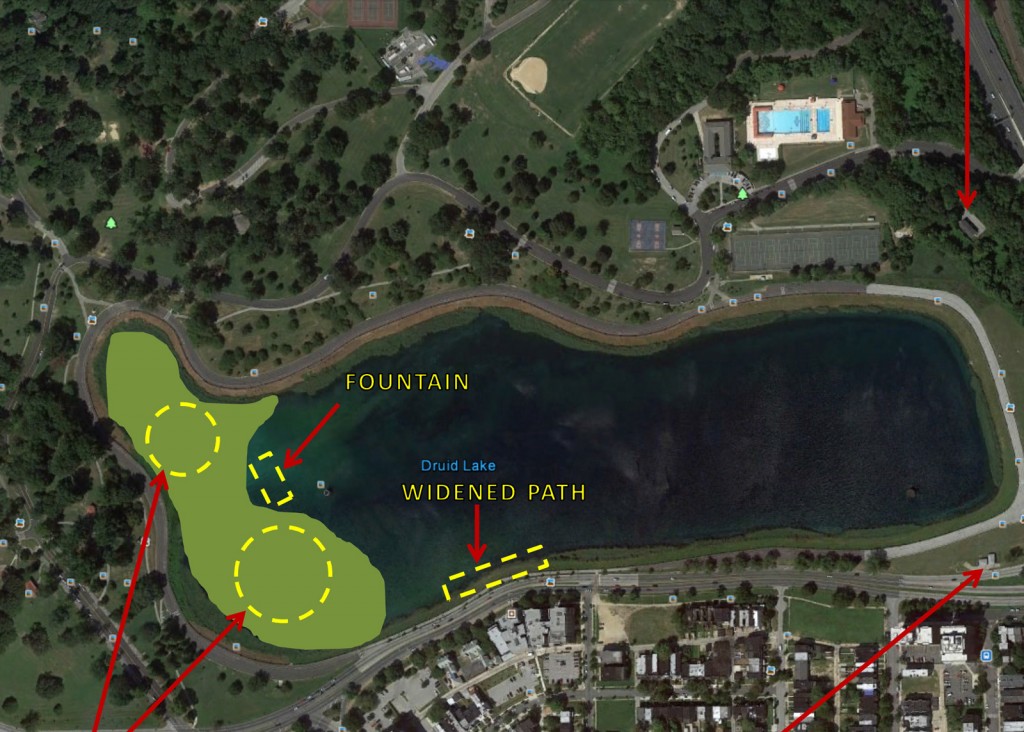- restore the existing fountain in Druid Reservoir;
- restore or rebuild the existing stone wall and ornamental iron fencing within the project area;
- widen the mixed-use path along Druid Hill Drive;
- and add new park amenities potentially including amphitheater, row boating facility.
Overview
In February 2013, the Baltimore City Department of Public Works presented a proposal to replace the Druid Hill Reservoir with buried water tanks and filters to meet new federal requirements for drinking water safety. If built, this initial proposal would have devastated the historic landscape of Druid Hill Park. The Friends of Druid Hill Park, together with area residents, Baltimore Heritage and other partners, encouraged DPW to work with the Baltimore City Department of Recreation and Parks (BCRP) to revise their proposal.
The Department of Public Works is now pursuing a revised project plan to install two precast, pre-stressed water storage tanks (400 –550 feet in diameter) underground in the western end of the original lake. The area above the buried tanks will be turned into a lawn for general park use. DPW, together with BCRP, has also committed to:
Location
Druid Hill Park, Baltimore, MD
Our Approach
Baltimore Heritage is continuing to work in partnership with the Friends of Druid Hill Park to monitor this issue. We encourage public involvement in this ongoing process and hope to ensure that Baltimore City fulfills their commitment to compatible design, restored historic fabric and improved amenities.
History
In 1863, the Baltimore City Council approved a $300,000 loan to construct a billion gallon capacity reservoir in the newly established Druid Hill Park. Though the new city waterworks project from Lake Roland to the Mount Royal Reservoir on the Jones Falls had just been completed, it had become apparent that the city’s water problems were far from solved. Having an abundance of natural springs and deep ravines, Druid Park seemed to be the perfect site for a new reservoir. In addition to providing suitable drinking water, this reservoir was also meant to enhance the beauty of the newly created park, accompanying its ancient oak trees bearing noble names such as “The Sentinel,” “King of the Forrest,” and “Tent Oak.”
A deep ravine formed by a stream that traveled southeast from the boat lake toward the Jones Falls was selected as the site for the new reservoir. Civil engineer Robert Martin developed plans and constructed a giant wall of mud that became the largest earthen dam in America (at that time). Steam excavators were used for the first time in the city to move 500,000 cubic yards of earth. The dam itself consisted of a water tight clay core, or puddle wall, surrounded by steep banks of soil, and was supported by a stone wall laid in cement running the entire length of the dam. Earthen banks were laid in thin layers and pressed by horse drawn rollers. When completed in 1871, the dam supported a reservoir that covered 55 acres, reached a depth of 94 feet (averaging 30 feet), and sat at an elevation 217 feet above mid-tide. Towering over the surrounding park at a height of 119 feet, the dam was 750 feet long, with a width of 600 feet at the base tapering up to 60 feet at the top.
The resulting body of water had been known during the first half of its construction as Lake Chapman, after Unionist Mayor and head of the Water Board at the time, John Lee Chapman (1811-1880). Since much of Chapman’s tenure as mayor was characterized by the bitter partisan feuding of the Civil War period, it came as little surprise when his Democratic successor, Robert T. Banks (1822-1901), and the City Council voted unanimously to change the name to Druid Lake just four months after he left office in early 1868. Over 140 years later the dam still holds strong, and in 1971 it was named a National Historic Civil Engineering landmark by the American Society of Civil Engineers.
Thank you to Eben Dennis for contributing this brief history of Druid Lake.
Read more at Explore Baltimore HeritageLast Updated: July 11, 2017
Related Documents
Thank you to the Friends of Druid Hill Park for distributing this essential background information about the project. Learn more about this issue through their website.
Rec and Park/DPW 1Oct 2014.pdf (PDF)
Druid Presentation_10_2014.pdf (PDF)
DHR_Plan_Update Oct 2013.pdf (PDF)
06.26.2012_Res_Hill_Mtg.pdf (PDF)
Investigation_of_Water_Storage_Locations Background Information.pdf (PDF)

